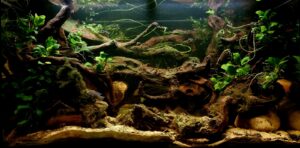Foto River near the town of Fria, north of Conakry, Konkoure River system
_st place in Biotope Aquarium Design Contest 2022

Volume of aquarium: 150 liters
Dimensions of aquarium: 85x40x45
List of fishes: Enigmatochromis Lucanusi x2 ; Epiplatys dageti x8
List of plants: Anubias sp. ; Bolbitis heudelotii ; Crinum calamistratum
Description of Decorations and Substrate: BASE COMPOSED OF EXTRA-FINE SAND + DRY LEAVES + VARIOUS DRY WOODS + RIVER STONES
Description of Equipment: FILTER: JBL CristalProfi E702 Greenline
LIGHT: 1 LED 5000°K 24W
Water Parameters: Ph 6.5
Kh 1
Temp. 24°C
Additional Info: Water change once a week 10% with RO
Aquarium video:
Description of the Area Surrounding the Biotope: Foto river is near Fria, it is a town and Sub-prefecture in Lower Guinea, lying north of Conakry near the Amaria Dam on the Konkouré River.
In the Fria city there is an bauxite-aluminum industry
Description of the Underwater Landscape of the Biotope: Foto river is an affluent of The Konkouré River that arises in west-central Guinea and flows into the Atlantic Ocean.[1] Several dams on the river provide the country with much of its electricity.
The konlkoure river originates in the Futa Jallon highland region and flows in a westerly direction 303 kilometres (188 mi) to the Atlantic Ocean north of the Baie de Sangareya (Sangareya Bay)[1] at 9°46’N, 14°19’W.[2] The Kakrima River is its major tributary.[2] The river delta covers 320 square kilometres (120 sq mi).[3] The “Lower Konkouré is a shallow, funnel shaped, mesotidal, mangrove-fringed, tide dominated estuary”.[4] Rice farms have been established in the mangrove areas of the delta “with some success
Foto river It is a small savannah river near the bauxite mining town of Fria in north Conakry of Guinea
Description of the Habitat Parameters: Ph 5.8
Kh 1
Temp.24°C – 30°C
List of Fishes and Invertebrates Occurring in the Nature Biotope: Enigmatochromis Lucanusi ; Epiplatys dageti ; pelvicachromis humilis
List of Plants Found in the Nature Biotope: Anubias sp. ; Bolbitis heudelotii ; Crinum calamistratum , vallisneria sp. ; Pistia strationes
Threats to the Ecology of the Biotope: There are many protected areas in Guinea (forêts classées), although little is done to enforce environmental protection regulations. The Mount Nimba Nature Reserve, in the far south-east of the country, along the border with the Ivory Coast, is classified as a World Heritage Site by UNESCO, which however has not prevented the government from opening an iron mine on the mountainside. Also nearby is the Forêt Classée de Ziama, where the rainforest remains untouched (at least for the moment) and elephants are often seen. The future of the two national parks, Parc Transfrontalier Niokolo-Badiar, near Koundara, and Parc National du Haut Niger, northeast of Faranah, is uncertain due to lack of funds.
The data relating to Guinea’s environmental protection are alarming. The population of almost all animal species is constantly decreasing and for most of the flora and fauna no basic data has ever been collected. The main problem is deforestation. The repatriation of most refugees has alleviated the problem of logging to make way for agricultural land, but logging continues, favored by the near total lack of controls, and is advancing so rapidly in the south that the Forest Region deserves a new name. . Along the coast, much of the mangrove forest has been cleared to make way for rice cultivation and unregulated fishing is becoming more and more of a problem. Large mining companies have pledged to improve mining methods and some signs that this is actually happening are already beginning to show.
Sources of Information:
https://it.m.wikipedia.org/wiki/Guinea
https://www.fishbase.de/
https://www.natureaquarium.it/pub.htm
